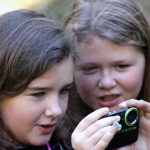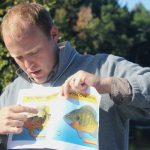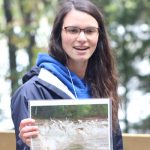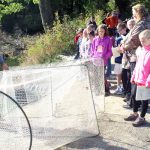Students spend day at Hartman Creek
By Greg Seubert
What do spiny water fleas, composting and beaver pelts have in common?
About 300 fifth-graders had a chance to learn about all three Sept. 29 at the Waupaca County Conservation Field Day.
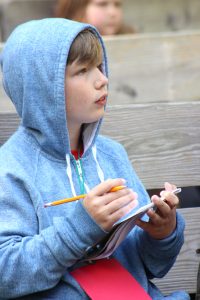
Stevens Point-based Golden Sands Resource Conservation & Development Council Inc. organizes the event, held each year at Hartman Creek State Park. This year’s event included students from Waupaca, Manawa, Clintonville and Marion schools.
Students rotated between 15 hands-on field stations including aquatic insects, learning to compost, conservation law enforcement, soils, agriculture, wildlife, forestry, wetlands, geocaching and more. They also recorded their experiences and observations in a journal.
Paige Reid gave a presentation in the park’s amphitheater on invasive animals and plants.
“The thing about aquatic invasives is that not a lot of people do really know about them,” she said. “Like I was telling the kids, lakes do a really good job of filtering themselves, but it does not take much for them to get off-kilter with so many people using lakes.
“These invasives can be really detrimental,” she said. “It can be a real issue. That’s why it’s really important for kids to be learning this. Future generations want to be able to enjoy the same lakes we do. They want to be fishing for the same fish. This is how we’re going to be able to do that.”
Reid’s presentation included a spiny water flea, which is so small that students had to use a magnifying glass to see the tiny insect, which entered the Great Lakes in the 1980s in ship ballast water from Europe. They eat smaller zooplankton, which puts them in direct competition for food with juvenile fish.
Invasive species found in Wisconsin also include Eurasian water-milfoil, a plant documented in several water bodies throughout Wisconsin, including more than 40 lakes in Waupaca County alone.
“I think our obvious goal is for kids to go home and say, ‘Hey, Mom and Dad, we should not do this.’ I was thinking when I was making the name tags that, ‘Wouldn’t it be cool if kids come to this day and all of a sudden they say they want to work in a fisheries department.’”
Just down the path from Reid’s station, Jason Breeggemann talked about the state Department of Natural Resources’ fisheries management program.
Breeggemann, a DNR fisheries biologist based in Shawano, set up a large fyke net to show how DNR crews capture fish to record information.
“The biggest thing I want the kids to take away is just get passionate about natural resources, in particular, fishing,” he said. “Make them want to go out and go fishing, see our wildlife and experience our natural resources so they can enjoy all the different opportunities that are available to them.”
Breeggemann’s talk also touched on preservation and conservation.
“We show them the ways we manage our fisheries in hopes that they’ll get excited about it and make sure that they conserve the fisheries for their kids and grandkids,” he said.
Breeggemann attended this year’s Field Day for the first time.
“There are so many different aspects of the outdoors that you just can’t fully experience in the classroom,” he said. “They can actually see one of the fyke nets we have set up here or one of the hoop nets that we put in the water. They can see pelts and feel the different types of fur that animals have.
“It just gives them an opportunity that they can’t get in the classroom,” he added. “A lot of their parents may have never seen a fyke net. For them to go home and say, ‘Mom, I saw a fyke net today’ might spur them to look it up on the Internet or do a little research about the history behind fisheries management. It might spark them to do a little bit for environmental conservation.”

